RealDeal Study Easy Solution
Having problems with assignments? Tough exams? Am an online tutor dealing with major courses in psychology, Nursing, Human Resource Management. I provide valid study resources in the form of study notes and exam reviews that ensure excellent grades in your exams and assignments
- 33
- 0
- 2
Community
- Followers
- Following
35 items
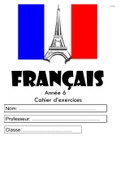
Learn French Langauge_Booklet_French Simplified_Lesson Four
Français Année 6 Cahier d’exercices Nom: ………………………………………… Professeur: …………………………………… Classe: ………………………… Contents page Le système phonique et la prononciation (Phonics and pronunciation) 1-2 Phrases utiles (Useful phrases) 3 Questions (Questions) 4 Révision:je me présente (Revision: Introductions) 5 Les numéros (Numbers) 6 Les mois et les saisons (months and seasons) 7 Les points cardinaux (the ...
- Package deal
- Other
- • 42 pages •
Français Année 6 Cahier d’exercices Nom: ………………………………………… Professeur: …………………………………… Classe: ………………………… Contents page Le système phonique et la prononciation (Phonics and pronunciation) 1-2 Phrases utiles (Useful phrases) 3 Questions (Questions) 4 Révision:je me présente (Revision: Introductions) 5 Les numéros (Numbers) 6 Les mois et les saisons (months and seasons) 7 Les points cardinaux (the ...
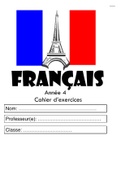
Learn French Language_Booklet_French Simplified Lesson Three
Français Année 4 Cahier d’exercices Nom: ………………………………………… Professeur(e): ………………………………… Classe: ………………………… Contents page Le système phonique et la pronunciation (Phonics and pronunciation) 1-4 Saluer (Greetings) 5-6 En classe (In the classroom) 7-8 Les numéros 1-31 (Numbers 1-31) 9-10 Quel âge as-tu ? (How old are you?) 9 Les mois de l’année (The months of the year) et les jours de la semaine (...
- Package deal
- Other
- • 50 pages •
Français Année 4 Cahier d’exercices Nom: ………………………………………… Professeur(e): ………………………………… Classe: ………………………… Contents page Le système phonique et la pronunciation (Phonics and pronunciation) 1-4 Saluer (Greetings) 5-6 En classe (In the classroom) 7-8 Les numéros 1-31 (Numbers 1-31) 9-10 Quel âge as-tu ? (How old are you?) 9 Les mois de l’année (The months of the year) et les jours de la semaine (...

Learn French Language_Booklet _French Simplified Lesson Two
Français Année 5 Cahier d’exercices Nom: ………………………………………… Professeur(e): ………………………………… Classe: ………………………… Contents page Le système phonique et la prononciation (Phonics and pronunciation) 1-2 Phrases utiles (Useful phrases) 3 Questions (Questions) 4 Les numéros (Numbers) 5-6 Quelle heure est-il ? (What time is it?) 7-9 Grammaire: ‘un/une/des’ (‘a’ and ‘some’) 11 La nourriture (Food) 10-...
- Package deal
- Other
- • 49 pages •
Français Année 5 Cahier d’exercices Nom: ………………………………………… Professeur(e): ………………………………… Classe: ………………………… Contents page Le système phonique et la prononciation (Phonics and pronunciation) 1-2 Phrases utiles (Useful phrases) 3 Questions (Questions) 4 Les numéros (Numbers) 5-6 Quelle heure est-il ? (What time is it?) 7-9 Grammaire: ‘un/une/des’ (‘a’ and ‘some’) 11 La nourriture (Food) 10-...
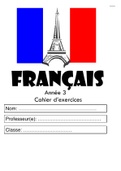
Learn French Language_Booklet_French Simplified Lesson One
Français Année 3 Cahier d’exercices Nom: ………………………………………… Professeur(e): ………………………………… Classe: ………………………… Contents page Les voyelles A, E, I, O, U, Y (The vowels) 1 Saluer (Greetings) 2-4 Se présenter (How to ask and give your name) 5 Les numéros 1-15 (Numbers 1-15) 6 -10 Quel âge as-tu ? (How old are you?) 11 Le système phonique et la prononciation (Phonics and pronunciation) 12-17 Dans ma trou...
- Package deal
- Other
- • 39 pages •
Français Année 3 Cahier d’exercices Nom: ………………………………………… Professeur(e): ………………………………… Classe: ………………………… Contents page Les voyelles A, E, I, O, U, Y (The vowels) 1 Saluer (Greetings) 2-4 Se présenter (How to ask and give your name) 5 Les numéros 1-15 (Numbers 1-15) 6 -10 Quel âge as-tu ? (How old are you?) 11 Le système phonique et la prononciation (Phonics and pronunciation) 12-17 Dans ma trou...

Human Anatomy and Physiology- Test Bank –Questions With Answers
Human Anatomy and Physiology- Test Bank – Chapter 1 Multiple-Choice Questions 1. Which of these is NOT part of the dorsal Cavity? A) Cranial cavity B) Vertebral cavity C) Thoracic cavity D) Spinal cord 2. Which of the following organs or structures would be found in the left iliac region? A) Appendix B) Stomach C) Liver D) Intestines 3. You are asked to take a person's heart rate at the popliteal pulse point. You will look for this pulse A) On the posterior side of th...
- Exam (elaborations)
- • 26 pages •
Human Anatomy and Physiology- Test Bank – Chapter 1 Multiple-Choice Questions 1. Which of these is NOT part of the dorsal Cavity? A) Cranial cavity B) Vertebral cavity C) Thoracic cavity D) Spinal cord 2. Which of the following organs or structures would be found in the left iliac region? A) Appendix B) Stomach C) Liver D) Intestines 3. You are asked to take a person's heart rate at the popliteal pulse point. You will look for this pulse A) On the posterior side of th...
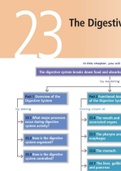
Human Anatomy and Physiology- Test Bank (Questions With Answers)
Human Anatomy and Physiology- Test Bank – Chapter 1 Multiple-Choice Questions 1. Which of these is NOT part of the dorsal Cavity? A) Cranial cavity B) Vertebral cavity C) Thoracic cavity D) Spinal cord 2. Which of the following organs or structures would be found in the left iliac region? A) Appendix B) Stomach C) Liver D) Intestines 3. You are asked to take a person's heart rate at the popliteal pulse point. You will look for this pulse A) On the posterior side of th...
- Exam (elaborations)
- • 58 pages •
Human Anatomy and Physiology- Test Bank – Chapter 1 Multiple-Choice Questions 1. Which of these is NOT part of the dorsal Cavity? A) Cranial cavity B) Vertebral cavity C) Thoracic cavity D) Spinal cord 2. Which of the following organs or structures would be found in the left iliac region? A) Appendix B) Stomach C) Liver D) Intestines 3. You are asked to take a person's heart rate at the popliteal pulse point. You will look for this pulse A) On the posterior side of th...

- Nursing Care of the Child With an Alteration in Cellular Regulation / Hematologic or Neoplastic Disorder
1. The nurse is conducting a physical examination of a toddler with suspected lead poisoning. Lab results indicate blood lead level 52 m g/dL. Which action would the nurse expect to happen next? A) Repeat testing within 2 days and prepare to begin chelation therapy as ordered B) Repeat testing within 1 week with education to decrease lead exposure C) Confirm with repeat testing in 1 month and referral to local health department D) Prepare to admit child to begin chelation therapy 2. A n...
- Exam (elaborations)
- • 13 pages •
1. The nurse is conducting a physical examination of a toddler with suspected lead poisoning. Lab results indicate blood lead level 52 m g/dL. Which action would the nurse expect to happen next? A) Repeat testing within 2 days and prepare to begin chelation therapy as ordered B) Repeat testing within 1 week with education to decrease lead exposure C) Confirm with repeat testing in 1 month and referral to local health department D) Prepare to admit child to begin chelation therapy 2. A n...
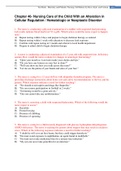
Hematology (Nursing Care of the Child With an Alteration in Cellular Regulation / Hematologic or Neoplastic Disorder)
1. The nurse is conducting a physical examination of a toddler with suspected lead poisoning. Lab results indicate blood lead level 52 m g/dL. Which action would the nurse expect to happen next? A) Repeat testing within 2 days and prepare to begin chelation therapy as ordered B) Repeat testing within 1 week with education to decrease lead exposure C) Confirm with repeat testing in 1 month and referral to local health department D) Prepare to admit child to begin chelation therapy 2. A n...
- Exam (elaborations)
- • 13 pages •
1. The nurse is conducting a physical examination of a toddler with suspected lead poisoning. Lab results indicate blood lead level 52 m g/dL. Which action would the nurse expect to happen next? A) Repeat testing within 2 days and prepare to begin chelation therapy as ordered B) Repeat testing within 1 week with education to decrease lead exposure C) Confirm with repeat testing in 1 month and referral to local health department D) Prepare to admit child to begin chelation therapy 2. A n...
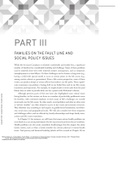
Family Matters Sociology
FAMILIES ON THE FAULT LINE AND SOCIAL POLICY ISSUES While life for many Canadians is relatively comfortable and trouble free, a significant number of families face considerable hardship and challenge. Some of these problems may be relatively short term with relatively modest consequences, such as temporary unemployment or a brief illness. Or these challenges can be chronic or long term (e.g., having a child with special needs) or occur at certain points in the life course (e.g., amo...
- Other
- • 124 pages •
FAMILIES ON THE FAULT LINE AND SOCIAL POLICY ISSUES While life for many Canadians is relatively comfortable and trouble free, a significant number of families face considerable hardship and challenge. Some of these problems may be relatively short term with relatively modest consequences, such as temporary unemployment or a brief illness. Or these challenges can be chronic or long term (e.g., having a child with special needs) or occur at certain points in the life course (e.g., amo...

CONCEPT: FUNDAMENTAL CHEMISTRY -BASIC CHEMISTRY
CONCEPT: FUNDAMENTAL CHEMISTRY Atoms: ● All matter is made of atoms. Atoms contain protons, neutrons, electrons. □ Protons= (+) charge □ Neutrons= 0 charge □ Electrons= (-) charge □ Atoms start with protons=electrons, so that they are neutral—no net _______________________. ● Atoms can gain or lose electrons to other atoms. When this happens, they become charged, and are called ions. □ An anion is an atom that has gained an electron—it’s a negative ion. □ A cation is...
- Exam (elaborations)
- • 18 pages •
CONCEPT: FUNDAMENTAL CHEMISTRY Atoms: ● All matter is made of atoms. Atoms contain protons, neutrons, electrons. □ Protons= (+) charge □ Neutrons= 0 charge □ Electrons= (-) charge □ Atoms start with protons=electrons, so that they are neutral—no net _______________________. ● Atoms can gain or lose electrons to other atoms. When this happens, they become charged, and are called ions. □ An anion is an atom that has gained an electron—it’s a negative ion. □ A cation is...
